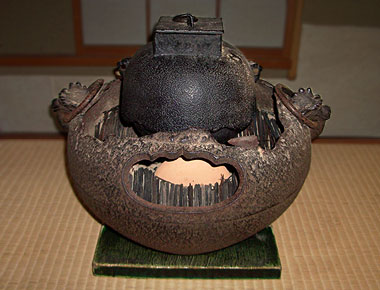|
||
 |
||

@
(C)2001 Japanese Architecture and Art Net Users System.@No reproduction or republication without written permission.
fΪΜeLXgEΚ^ECXgΘΗASΔΜRecΜ³f‘»E]ΪπΦΆά·B
|
||||||
| @ | ||||||
| furo@F | ||||||
| KEY WORD :@architecture / tea houses | ||||||
| @ | ||||||
| A portable brazier used in the spring and summer seasons when the hearth or fire-box *ro F, is closed, or when the tea ceremony is performed in a room where there is no fixed hearth. Furo have a variety of shapes and the earliest ones were made of bronze but later iron and clay braziers became common. The unglazed clay brazier coated with black lacquer was preferred for formal use. It was placed on a lacquered board *ko-ita ¬Β, to prevent heat damage. The iron type was set on a paving tile sengawara κ’. On the edge of a brazier a fire window or cut-out opening provided the necessary draft to keep the charcoal burning properly. A bed of ashes was laid inside the brazier and the charcoal placed on top was lighted. The kettle was then set directly on the bronze or iron brazier, but a trivet was used for a clay brazier. Kettles for portable ranges were slightly smaller than those used for fixed hearths. Semi-formed tea ceremony sometimes used a Chinese copper brazier karakane furo ΊF. | ||||||
| @ | ||||||
 |
||||||
@ |
||||||
| REFERENCES: | ||||||
| @ | ||||||
| EXTERNAL LINKS: | ||||||
| @@ | ||||||
| NOTES: | ||||||
| @ | ||||||
(C)2001 Japanese Architecture and Art Net Users System.@No reproduction or republication without written permission. fΪΜeLXgEΚ^ECXgΘΗASΔΜRecΜ³f‘»E]ΪπΦΆά·B |
||||||
| @ |